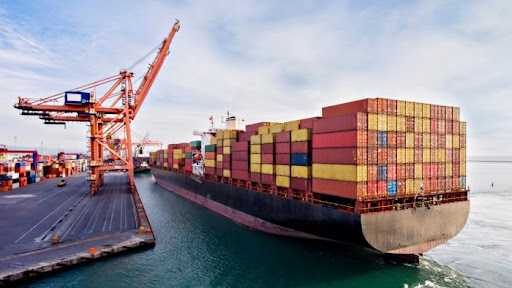Water Transport
Characteristics of Water Transportation
 Photo courtesy of NavataOpens in new window
Photo courtesy of NavataOpens in new window
Water carriage—as the oldest mode of transportation—accounts for 5% of total freight ton-miles (around 3.3% of actual tonnage) in the United States. Sampson et al. describe the nature and characteristics of water carriage as follows: |
Water carriage by nature is particularly suited for movements of heavy, bulky, low-value-per-unit commodities that can be loaded and unloaded efficiently by mechanical means in situations where speed is not of primary importance, where the commodities shipped are not particularly susceptible to shipping damage or theft, and where accompanying land movements are unnecessary.
As already mentioned, the majority of commodities transported by water are semiprocessed and raw materials; thus, water transportation competes primarily with railOpens in new window and pipelineOpens in new window.
Water carriage can be broken into the following distinct categories:
- Inland waterways (such as rivers and canals)
- Lakes
- Coastal and intercoastal oceans
- International deep sea
Water transportation service is limited in scope, mainly for two reasons: its limited range of operation and speed.
Water service is confined to waterway systems; thus, unless the origin and the destination of movement are located on waterways, it needs to be supplemented by another transportation mode (rail or motor carrier).
In addition, the average speed of water carriage is less than rail transport, and the availability and dependability of its service are greatly influenced by weather. Containers are used for many domestic and most international water shipments.
Moving freight in containers on containerized ships affects the intermodal transfer by reducing handling time and shortening total transit time. It also reduces staffing needs and allows shippers to take advantage of volume shipping rates.
Finally, containers reduce loss and damage. For all these reasons, high-value commodities (especially those in foreign shipments) are shipped in containers and containerized ships.
Loss and damage costs for water carriage are lower in comparison with other transportation modes because damage is not much of a concern with low-valued bulk commodities.
Also, because large inventories are often maintained by buyers, losses from delays are not serious. For high-valued products, claims are much higher; approximately 4% of ocean-ship revenues. Most damages are caused by rough handling during loading and unloading operations, so substantial packaging is needed to protect goods.
Regardless of the limitations inherent in water transportation, water is the least inexpensive mode for transporting high-bulk, low-value freights. The fixed cost of water carriage is mainly found in terminal facilities and transport equipment.
Although water carriers have to develop and operate their own terminals, rights-of-way and harbors are developed and maintained publicly. This moderates water-transport fixed costs, putting the mode between rail and motor carriages.
Water-transport variable costs, including waterway charges and transport equipment operation costs, are very low. Because of the high fixed cost and low line-haul costs of water carriage, its costs per ton-mile decrease significantly as the distance and shipment size increase.
See also:
- J.C. Johnson, D.F. Wood, D.L. Wardlow, P.R. Murphy, Contemporary Logistics, seventh ed., Prentice Hall, Upper Saddle River, NJ, 1999, pp. 1 – 21.
- A. Rushton, P. Crouche, P. Baker, The Handbook of Logistics and Distribution Management, third ed., Kogan Page, London, 2006.
- S.C. Ailawadi, R. Singh, Logistics Management, Prentice Hall of India, New Delhi, 2005.
- R.H. Ballou, Business Logistics/Supply Chain Management: Planning, Organizing, and Controlling the Supply Chain, fifth ed., Pearson-Prentice Hall, Upper Saddle River, NJ, 2004.
- J.R. Stock, D.M. Lambert, Strategic Logistics Management, fourth ed., Irwin McGraw-Hill, New York, 2001.
- G. Ghiani, G. Laporte, R. Musmanno, Introduction to Logistics Systems Planning and Control, John Wiley & Sons, NJ, 2004, pp. 6 – 20.
- M. Hugos, Essentials of Supply Chain Management, John Wiley & Sons, Hoboken NJ, 2003, pp. 1 – 15.
- H.T. Lewis, J.W. Culliton, J.D. Steel, The Role of Air Freight in Physical Distribution, Division of Research, Graduate School of Business Administration, Harvard University, Boston, MA, 1956, p. 82.
- D. Riopel, A. Langevin, J.F. Campbell, The network of logistics decisions, in: A. Langevin, D. Riopel (Eds.), Logistics Systems: Design and Optimization, Springer, New York, 2005, pp. 12–17.
- M. Browne, J. Allen, Logistics of food transport, in: R. Heap, M. Kierstan, G. Ford (Eds.) Food Transportation, Blackie Academic & Professional, London, 1998, pp. 22–25.
- J. Drury, Towards More Efficient Order Picking, IMM Monograph No. 1, The Institute of Materials Management, Cranfield, 1988.

